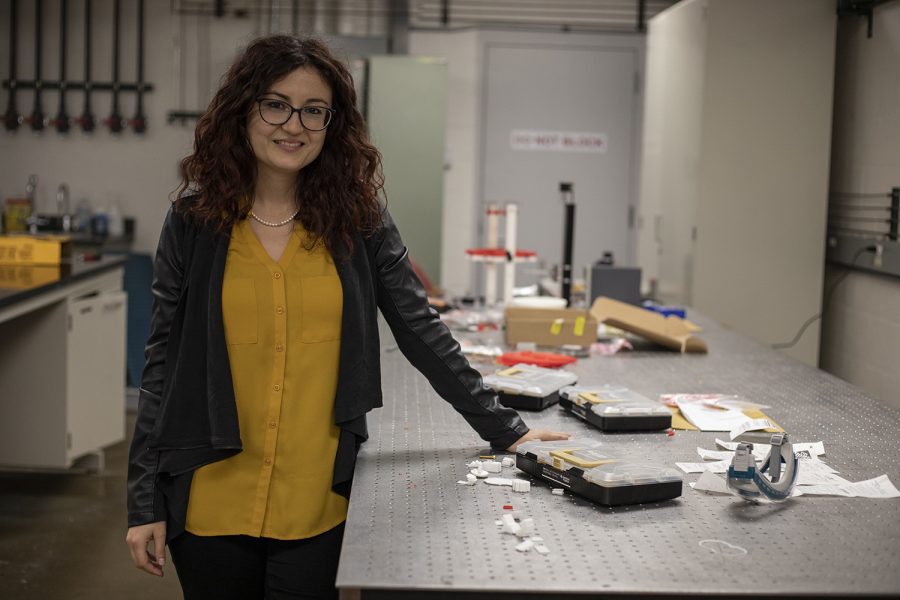UI researchers develop smart skin for the U.S. Navy
Caterina Lamuta, an assistant professor in Mechanical Engineering, is developing a morphing smart skin for the United States Navy.
Assistant Professor of Mechanical Engineering Caterina Lamuta poses for a portrait in a lab in the Advanced Technology Lab on Wednesday, September 25, 2019. The research for the material is still ongoing.
September 26, 2019
University of Iowa researchers recently developed a new smart skin which performs texture, color, and shape modulations to camouflage marine vehicles for the U.S. Navy. The smart skin reduces drag for marine vehicles and instantaneously creates braille for the visually impaired.
UI Assistant Professor in Mechanical Engineering Caterina Lamuta arrived on campus last fall with a partially completed invention and only one graduate student in her lab. Now, Lamuta’s Smart Multifunctional Material Systems Lab employs 11 members that developed the smart skin.
With artificial muscle underneath, the smart skin can morph into different shapes similar to the ability of a cephalopod, she said.
“The octopus, the cod fish, the squid, or the cephalopod basically have voxel muscle underneath the skin,” Lamuta said. “They can change the color, the roughness, the texture, and the shape of the skin. They do this to camouflage and control hydrodynamic drag.”
Lamuta initially developed the idea as a postdoctoral fellow at the University of Illinois – Urbana-Champaign with professors Sameh Tawfick and Nancy Sottoes.
The trio wrote a study that would eventually be published in the Advanced Materials Technologies journal, Lamuta said. The study described the team’s discovery that using coiled polymer fibers for the artificial muscles creates a lightweight skin perfect for constant movement and modulation, she said.
RELATED: College of Engineering introduces certificate in naval hydrodynamics
With the $430,000, three-year grant Lamuta received from the Office of Naval Research, her lab is now working to improve the model, she said. Because the artificial muscles are so lightweight, they are not strong enough to hold up the skin that will cover them, she said.
As one of Lamuta’s nine undergraduates currently working on the project, UI senior Alyssa Reis started researching new materials that would make the muscles strong enough to hold up the coating.
“I was researching other materials to see if there was something else we could use like nylon with glass reinforced or a different metal,” Reis said. “We’re just trying a bunch of different models.”
UI graduate student Parth Kotak works with Reis and the rest of the lab to develop a new material suitable for the artificial muscle. In addition to more strength, Kotak hopes to improve the efficiency of the model.
“It’s one of those projects where you know what you’re working on,” Kotak said. “It’s not aimless.”
While Lamuta’s smart skin was developed with submarines in mind, she said this invention could also apply to the U.S. Air Force, and the submarine drag-preventions techniques can be applied to aerial drag.
Lamuta predicts her invention will also benefit the medical field. She said the combination of artificial muscles and smart skin could provide haptic feedback during surgeries completed by robotic machines.
“We are still far from [the final application],” Lamuta said. “This is the very first prototype, so it will take some time to optimize and control the artificial muscles and output force.”






